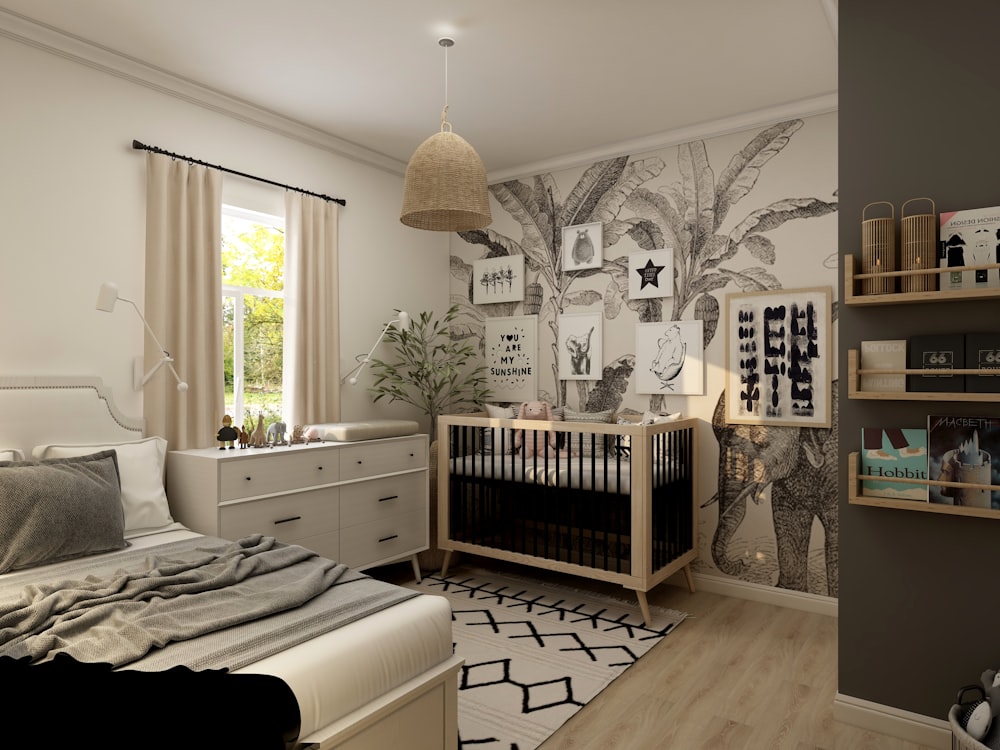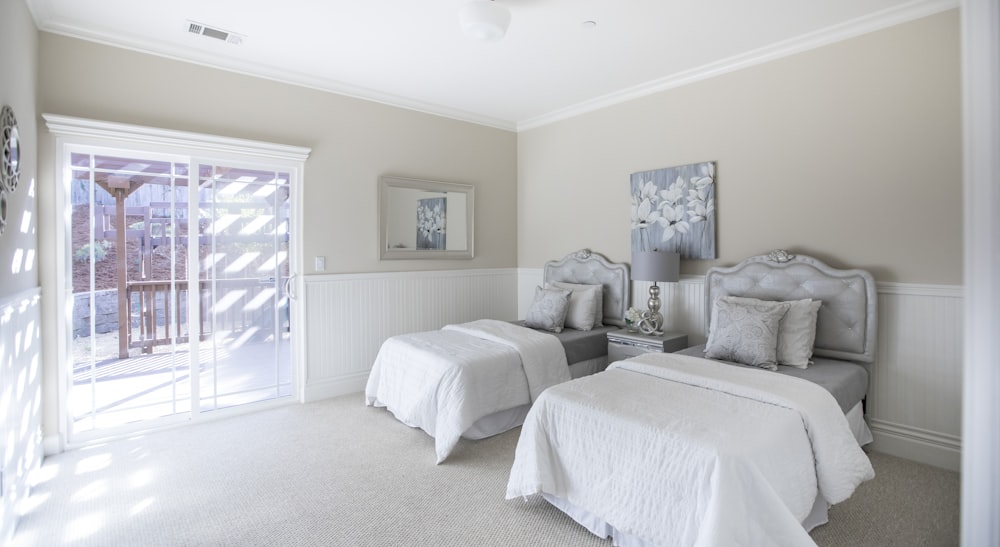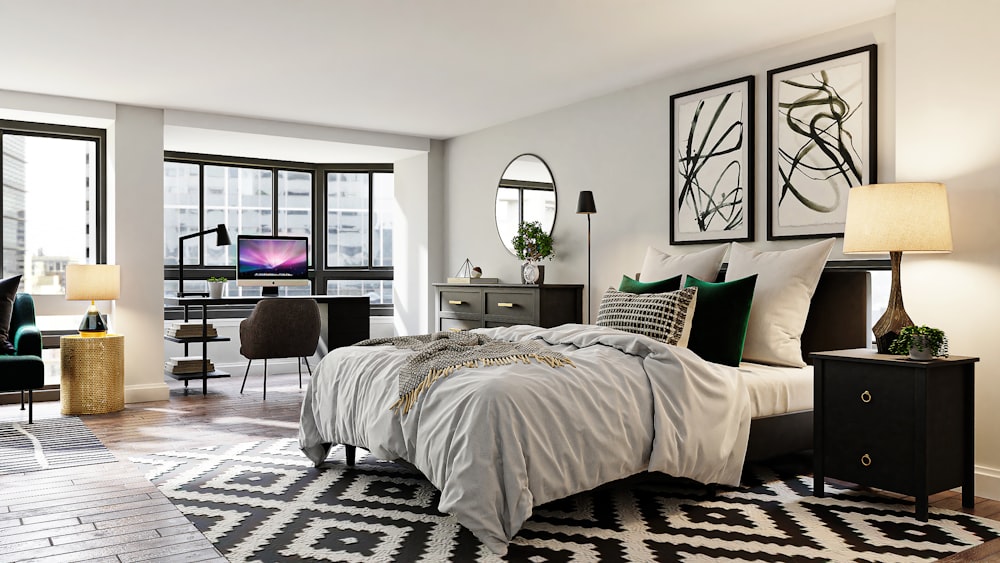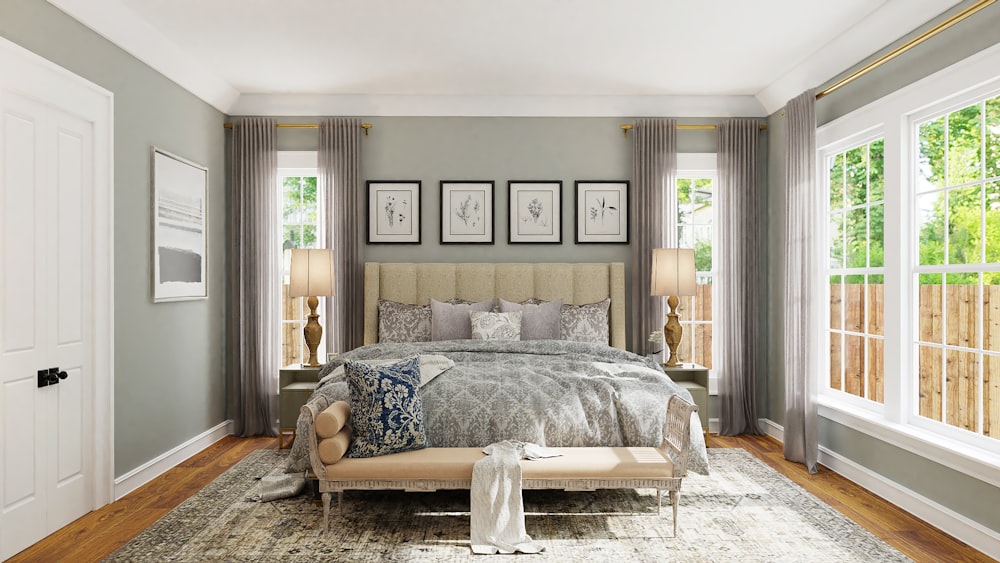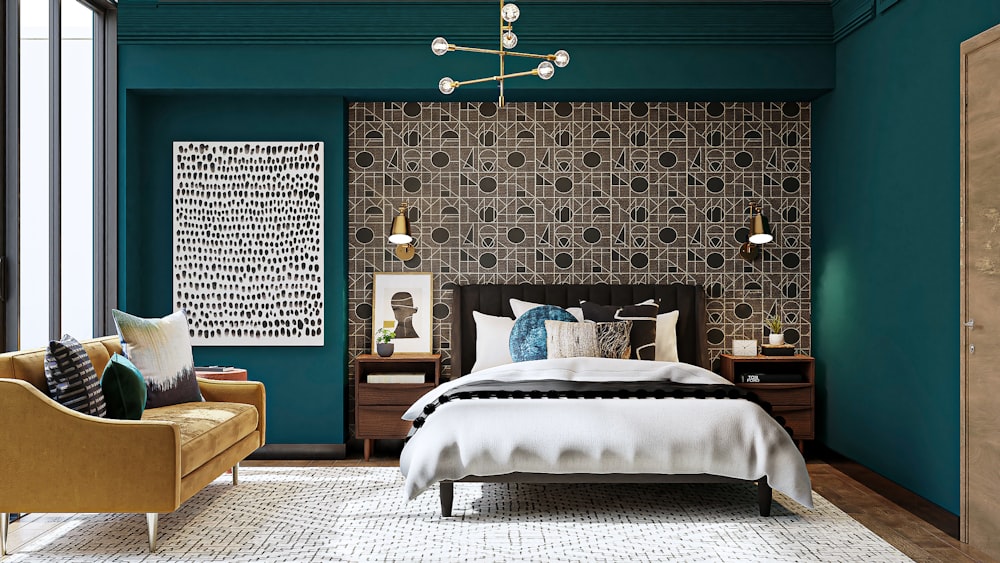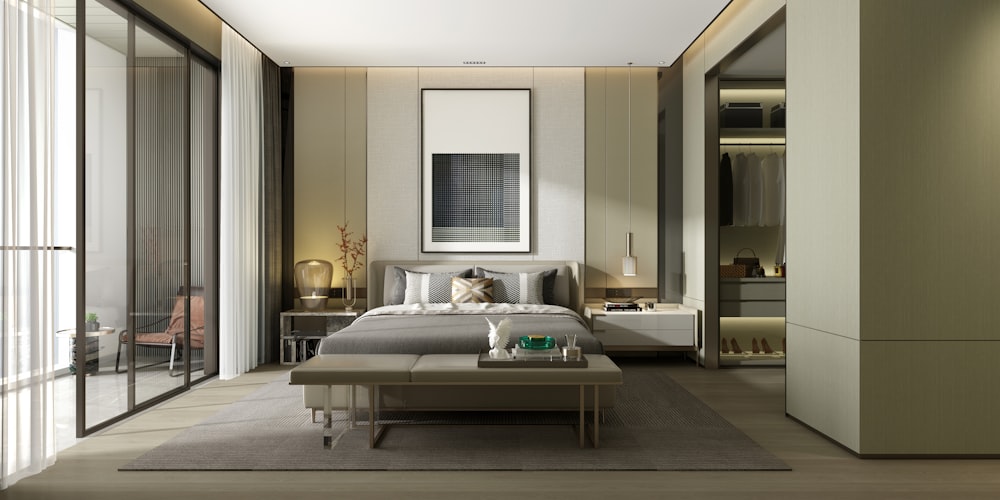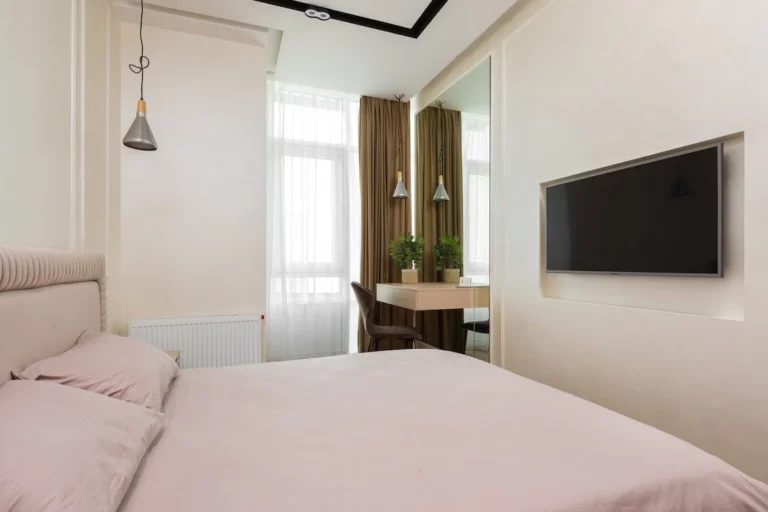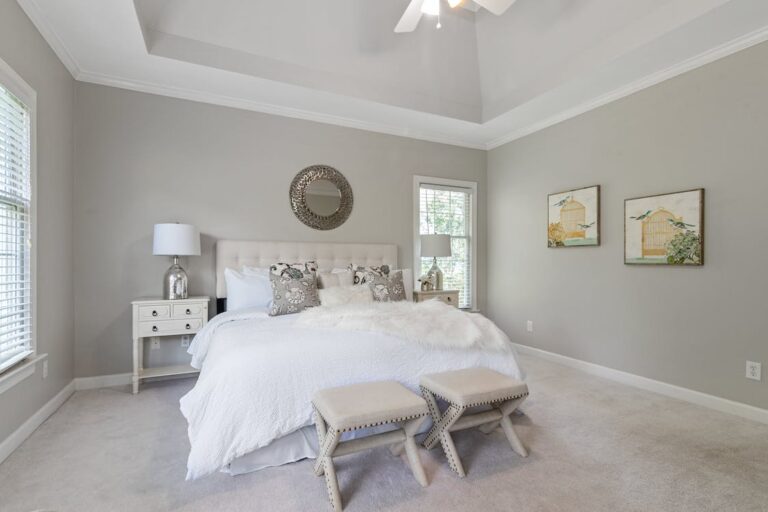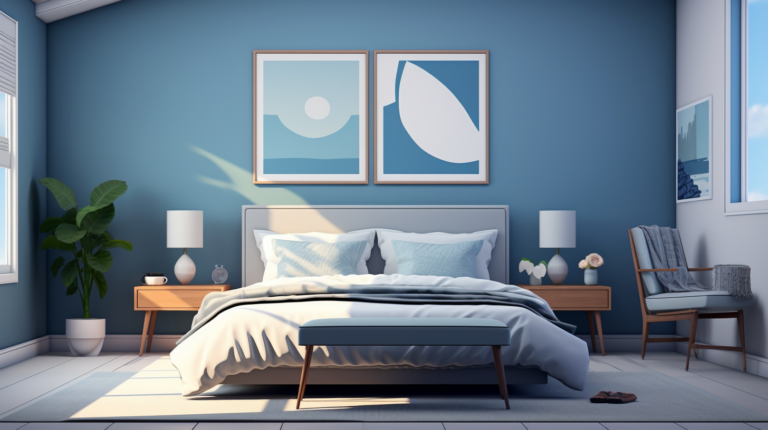Tips for Mixing Patterns in Your Bedroom Decor in 2024
Hey there! Are you looking to give your bedroom decor a fresh new look? One way to add personality and energy to your space is by mixing patterns. Mixing patterns in your bedroom decor is a popular design technique that can help you create a unique and visually interesting bedroom. However, it can be a bit tricky to get right. That’s why I’m here to share some tips and tricks to help you master the art of pattern mixing in your bedroom decor.
Pattern mixing involves combining different patterns, such as stripes, florals, and geometric prints, in one space. The goal is to create a cohesive and harmonious look that doesn’t overwhelm the room. So, if you’re ready to take your bedroom decor to the next level, let’s dive into the world of pattern mixing!
Table of Contents
- 1 Understanding the Basics of Pattern Mixing
- 2 Current Trending Designs
- 3 Creating a Focal Point with Pattern
- 4 Maintaining Cohesion in Pattern Mixing
- 5 Adding Depth to Design by Mixing Patterns in Your Bedroom Decor
- 6 Balancing Patterns with Solids
- 7 Unifying Different Patterns
- 8 Understanding Color and Texture in Pattern Mixing
- 9 Conclusion
- 10 Frequently Asked Questions
Understanding the Basics of Pattern Mixing
Pattern mixing is a fun and creative way to add visual interest and personality to your bedroom decor. By combining different patterns, you can create a unique and eclectic look that reflects your personal style. However, it’s important to understand the basics of pattern mixing to ensure that your design is cohesive and visually appealing. Here are some key things to consider when mixing patterns in your bedroom decor:
Rule of Three
When it comes to pattern mixing, the rule of three is a helpful guideline to follow. This means using at least three different patterns in a room to create balance and variety. However, you don’t want to go overboard and use too many patterns, as it can become overwhelming. Start by choosing three different compatible colors and then select patterns in varying scales to create a harmonious look.
Choosing Compatible Patterns
When choosing patterns for your bedroom decor, it’s essential to select ones that are compatible with each other. Look for patterns that share similar colors or design elements to create a cohesive look. For example, if you have a floral pattern on your bedding, you could pair it with a geometric pattern on your curtains or a striped pattern on your accent pillows. Mixing different types of patterns can add energy and personality to a room.
Importance of Texture
In addition to patterns, don’t forget about the importance of texture in your bedroom decor. Mixing different textures, such as smooth fabrics, soft knits, or textured wallpapers, can add depth and visual interest to your space. Consider adding a textured throw blanket or a patterned rug to enhance the overall design. Texture can help balance out the patterns and create a more visually appealing and inviting atmosphere.
“Pattern mixing adds personality and energy to a room.”
Remember, the goal of pattern mixing is to create a visually pleasing and cohesive design. By following these basic principles, you can confidently mix patterns in your bedroom decor and achieve a stylish and unique look. In the next section, we will explore some current trending designs that incorporate pattern mixing.
Current Trending Designs
When it comes to mixing patterns in your bedroom decor, staying up to date with the latest trends can help you create a stylish and visually appealing space. Here are two current trending designs that you can incorporate into your pattern mixing:
Maximalist Designs
Maximalist designs are all about embracing bold patterns and going for a more eclectic and daring look. This trend encourages you to mix patterns with confidence and create a visually stimulating space. Here are a few tips for achieving the maximalist look in your bedroom:
- Mix different patterns and colors: Don’t be afraid to mix florals with stripes or geometric prints with animal prints. The key is to have fun and experiment with different combinations.
- Layer patterns: Layering patterns can create a dynamic and textured look in your bedroom. Combine patterns on your bedding, curtains, rugs, and accessories to add depth and visual interest.
- Play with scale: Mixing patterns of different scales can create a balanced and harmonious look. Pair larger scale patterns with smaller scale ones to add variety and keep the eye moving.
Cluttercore
Cluttercore is a trend that embraces a more eclectic and lived-in look. It celebrates the beauty of imperfections and encourages you to showcase your personal style through your decor. Here’s how you can incorporate cluttercore into your pattern mixing:
- Mix vintage and modern patterns: Combine vintage patterns, such as floral prints or paisley, with more contemporary patterns, like geometric or abstract designs. This creates a layered and curated look.
- Embrace mismatched patterns: Don’t worry about everything being perfectly coordinated. Mix and match patterns that speak to your personal style and create a unique and eclectic feel.
- Add personal touches: Incorporate sentimental items, such as family heirlooms or handmade crafts, into your bedroom decor. This adds a personal touch and gives your space a lived-in and personalized feel.
By incorporating these trending designs into your pattern mixing, you can create a bedroom that is both stylish and on-trend. Remember to have fun and experiment with different patterns and colors to create a space that reflects your personal style. Happy decorating!
Creating a Focal Point with Pattern
When it comes to mixing patterns in your bedroom decor, one of the key elements to consider is creating a focal point. A focal point helps draw the eye and sets the tone for the overall design of the room. Here are some tips on how to use patterns to create a clear focal point in your bedroom:
- Focus on one large-scale pattern: To create a strong focal point, choose one large-scale pattern as the main focus of the room. This could be a bold floral wallpaper, a statement rug, or a standout duvet cover. By using a larger pattern, you can immediately grab attention and create a sense of visual interest.
“When it comes to pattern mixing, it’s important to have a focal point that commands attention. Choose one large-scale pattern that serves as the main attraction in the room.”
- Coordinate colors: When selecting your focal point pattern, consider coordinating the colors with the rest of the room. This will help create a cohesive and visually pleasing design. You can choose colors that complement each other or opt for contrasting shades to add drama and excitement to the space.
- Keep surrounding patterns simple: To ensure that your focal point pattern stands out, it’s important to keep the surrounding patterns relatively simple. This will prevent the room from feeling overwhelming and chaotic. Choose smaller-scale patterns or solid colors for the accompanying pieces of furniture and decor.
“To create a focal point with pattern, it’s important to keep the surrounding patterns simple. This will help the main pattern stand out and avoid overwhelming the room.”
- Balance the visual weight: When creating a focal point with pattern, it’s important to balance the visual weight of the room. If your focal point is on one side of the room, consider adding smaller patterns or pops of color on the opposite side to create a sense of balance and symmetry.
By following these tips, you can effectively create a focal point with pattern in your bedroom decor. This will not only add visual interest to the space but also set the tone for the overall design of the room. Don’t be afraid to experiment and have fun with different patterns and colors that reflect your personal style.
Maintaining Cohesion in Pattern Mixing
When it comes to mixing patterns in your bedroom decor, maintaining cohesion is key. While you want to create an eclectic and visually interesting space, you don’t want it to look chaotic or overwhelming. Here are some tips to help you maintain cohesion in pattern mixing:
1. Color Cohesion
Using similar colors when mixing patterns can help tie the different elements together and create a cohesive look. This doesn’t mean you have to stick to the exact same colors, but instead, choose patterns that have a common color palette. For example, if you have a floral pattern with shades of pink and green, you can pair it with a striped or geometric pattern that also incorporates those colors.
2. Pattern Scale
Combining patterns with different scales can help create balance in your bedroom decor. Pairing a large-scale pattern with a smaller-scale one can add visual interest and prevent the space from feeling too busy. For example, you can mix a large floral print with a small polka dot or a bold stripe with a subtle herringbone pattern.
3. Using Similar Colors
Sticking to a few colors can help multiple patterns become cohesive. Choose a color palette of two to three colors and incorporate them throughout your patterns. This could be done through your bedding, curtains, throw pillows, or even wallpaper. Having the same colors repeated in multiple patterns will create a sense of harmony in your bedroom decor.
“Maintaining cohesion in pattern mixing is all about finding commonalities in color, scale, and design elements. By using similar colors, balancing pattern scales, and sticking to a cohesive color palette, you can create a visually pleasing and harmonious space.” – Expert Designer
Remember, the goal is to create a visually appealing and harmonious space, not a mishmash of conflicting patterns. Taking the time to think about color cohesion, pattern scale, and using similar colors will ensure that your pattern mixing efforts result in a beautiful and cohesive bedroom decor.
In the next section, we will explore how mixing patterns can add depth and excitement to your bedroom design. So, let’s dive in!
Also Read: Inspiring Bedroom Designs for Small Spaces in 2023
Adding Depth to Design by Mixing Patterns in Your Bedroom Decor
When it comes to interior design, one of the most effective ways to add depth and excitement to a space is by mixing patterns. Pattern mixing allows you to create a unique and personalized look that can completely transform a room. Whether you want to create a bold and eclectic space or a more subtle and cohesive design, understanding how to add depth to your design with pattern mixing is essential. Let’s dive in!
Mixing patterns can add depth and excitement to a design. It adds interest and visual appeal to a space, giving it a custom feel. Instead of relying solely on solid colors or single patterns, incorporating different patterns can make a room come alive. Here are a few tips to help you successfully add depth to your design through pattern mixing:
- Start with a focal point: One way to add depth to a design is by focusing on one large-scale pattern to create a clear focal point. This could be a patterned wallpaper, a vibrant area rug, or even a statement piece of furniture. By incorporating a bold pattern as a focal point, you can build the rest of the design around it, creating visual interest and depth.
- Mix patterns of different scales: Combining patterns with different scales can help create balance in a space. Pairing a large-scale pattern with a smaller-scale one adds visual interest and prevents the design from feeling overwhelming. For example, you can pair a large-scale floral print with smaller geometric patterns or stripes.
- Stick to a few colors: When mixing patterns, it’s essential to stick to a limited color palette. Using similar colors throughout different patterns can help tie the design together and maintain a sense of cohesiveness. If you want to add depth, consider incorporating different shades and tones of the same color to create a layered effect.
- Balance patterns with solids: While pattern mixing is all about creating depth and visual interest, it’s important to balance the patterns with solids. Too many patterns can make a room feel chaotic and overwhelming. Introduce solid colors to provide a visual break and allow the patterns to shine. Experiment with different intensities of color to find the right balance for your space.
- Consider texture: Adding texture to your pattern mixing can further enhance the depth of your design. Incorporate different textures through textiles, such as velvet, linen, or faux fur, to create a tactile experience in your space. Combining patterns with varying textures adds another layer of interest and makes the design more visually appealing.
By incorporating these tips into your pattern mixing, you can create a space that is visually dynamic, exciting, and full of depth. Remember, the key is to experiment and have fun with your designs. Don’t be afraid to mix different patterns and take risks. After all, your home should be a reflection of your unique style and personality.
So, go ahead and start experimenting with pattern mixing to add depth and excitement to your interior design. With a little creativity and some careful consideration of colors, scales, and textures, you can create a space that is truly one-of-a-kind!
Balancing Patterns with Solids
When it comes to mixing patterns in your bedroom decor, finding the right balance is crucial. Using too many patterns can make a room feel overwhelming and chaotic. That’s where solids come into play. Incorporating solids into your pattern mixing design can help create balance and prevent your room from looking too busy. Here are some tips for balancing patterns with solids:
1. Think about the intensity of the color palette
When choosing solids to balance out your patterns, consider the intensity of the colors used in your patterns. If your patterns have bold and vibrant colors, opt for solid colors in a more muted or neutral tone to create a sense of harmony. On the other hand, if your patterns are more subtle or monochromatic, you can play with bolder solid colors to add a pop of excitement to the room.
2. Consider the scale of the patterns
Another important aspect to keep in mind is the scale of the patterns you’re using. If you have large-scale patterns, balancing them with solids can help give the eye a place to rest. On the other hand, if your patterns are on the smaller side, you can incorporate solids in larger furniture pieces or accessories to create a visual balance in the room.
3. Use solids as a backdrop
Solids can also serve as a backdrop for your patterns, allowing them to take center stage. For example, if you have a patterned accent wall or a bold patterned rug, using solid-colored furniture or bedding can help accentuate the patterns and make them stand out.
4. Create visual hierarchy
When balancing patterns with solids, it’s essential to create visual hierarchy in the room. This means giving more emphasis to certain patterns or solid colors to create a focal point. For example, if you have a patterned duvet cover, balance it out with solid-colored pillow shams and throw blankets, allowing the pattern to be the focal point of the bed.
5. Experiment with texture
In addition to using solid colors, you can also create balance by incorporating different textures into your pattern mixing design. Mixing textures adds depth and visual interest to the room. For example, if you have a patterned chair, pair it with a solid-colored velvet or faux fur throw pillow to create a contrast in texture.
Remember, incorporating solids into your pattern mixing design doesn’t mean you have to be boring or play it safe. Solids can be just as impactful and visually interesting as patterns. By finding the right balance between patterns and solids, you can create a harmonious and visually appealing space.
So go ahead, have fun with mixing patterns, and don’t forget to add some solids into the mix to create balance in your bedroom decor. Your room will thank you for it!
Unifying Different Patterns
When it comes to mixing patterns in your bedroom decor, it’s important to find ways to unify different patterns to create a cohesive and visually appealing look. Here are some tips to help you achieve that:
Using Similar Colors
One way to bring together different patterns in a room is by using similar colors. When the colors in your patterns complement each other or have a common thread, it helps create a visual connection and makes the overall design feel harmonious. For example, if you have a floral patterned duvet cover with shades of pink and green, you can incorporate throw pillows with a geometric pattern that also features those colors. This will help tie the two patterns together and create a unified look.
Repeating a Print
Another way to unify different patterns is by repeating a print throughout the room. Whether it’s through wallpaper, upholstery, or accessories, repeating the same pattern adds continuity to the design. For example, if you have a striped wallpaper in your bedroom, you can choose curtains or accent pillows with the same stripe pattern. This repetition creates a cohesive look and ties the various patterns together.
When it comes to mixing patterns, remember that the goal is to create a visually interesting and coordinated design. By using similar colors and repeating patterns, you can unify different patterns and achieve a cohesive look in your bedroom decor.
“Unify different patterns using similar colors or repeating the same print.”
Understanding Color and Texture in Pattern Mixing
When it comes to pattern mixing in your bedroom decor, understanding color and texture is crucial. The combination of different patterns can create a visually striking and cohesive design if done right. Here are some tips for incorporating color and texture into your pattern mixing:
Complementary Colors
When mixing patterns, it’s important to consider the color palette to create a harmonious look. One way to achieve this is by using complementary colors. Complementary colors are opposite each other on the color wheel and create a pleasing contrast when paired together. For example, blue and orange, or purple and yellow are complementary colors. By incorporating complementary colors into your pattern mixing, you can achieve a balanced and visually appealing design.
Mix of Textures
In addition to color, texture is another element that adds depth and interest to a room. When mixing patterns, it’s important to incorporate a mix of textures to create a visually dynamic space. This can be achieved by combining patterns with different textures such as smooth, rough, shiny, or tactile fabrics. For example, pairing a floral print with a striped pattern or a geometric print with a textured fabric can create an intriguing contrast in texture.
“When mixing patterns, use complementary colors and a mix of textures.”
By incorporating a mix of textures into your pattern mixing, you can create a visual balance and prevent the room from feeling flat or one-dimensional.
Consider the Mood
When choosing colors and textures for your pattern mixing, it’s important to consider the mood you want to create in your bedroom. Different colors evoke different emotions and can have a significant impact on the overall atmosphere of the space. For example, cool colors like blues and greens create a calming and peaceful ambiance, while warm colors like reds and yellows can evoke a sense of energy and warmth.
Additionally, textures also play a role in setting the mood of a room. Soft, plush fabrics can create a cozy and inviting atmosphere, while sleek, smooth textures can give a more modern and sleek feel.
By thinking about the mood you want to create in your bedroom, you can select colors and textures that align with that vision and create a space that feels harmonious and inviting.
In conclusion, when it comes to pattern mixing in your bedroom decor, understanding color and texture is key. By incorporating complementary colors, mixing textures, and considering the mood you want to create, you can create a visually striking and cohesive design that reflects your personal style. So go ahead, explore different patterns, experiment with colors, and have fun creating a space that is uniquely yours.
Also Read: The Art of Bedroom Organization : Maximizing Space and Functionality in 2023
Conclusion
In conclusion, pattern mixing is a fun and creative way to add personality and energy to your bedroom decor. By following the basic principles of pattern mixing and understanding how to maintain cohesion and balance, you can create a visually stunning and cohesive space. Here are some key takeaways to keep in mind:
- The rule of three: Use at least three patterns in a room to create interest and dimension.
- Choose compatible patterns: Start by choosing three different patterns that share compatible colors.
- Importance of texture: Incorporate different textures to add depth and variety to your pattern mixing.
Additionally, staying up to date with current trending designs, such as maximalist designs and cluttercore, can give you inspiration for new and exciting pattern mixing ideas. Remember, creating a focal point with a large-scale pattern can help draw attention and add visual interest.
Maintaining color cohesion by using similar colors in your patterns, balancing pattern scales, and incorporating solid colors to balance the intensity of the color palette are essential for achieving a cohesive look. Unifying different patterns can be done by using similar colors or by repeating a specific print throughout the room.
Understanding color and texture in pattern mixing is crucial. Using complementary colors and mixing different textures can help create a harmonious and visually pleasing space.
By keeping these tips in mind and experimenting with patterns and colors, you can create a bedroom decor that is unique and reflective of your personal style. Don’t be afraid to step outside your comfort zone and have fun with mixing patterns in your bedroom. Happy decorating!
For more information and design ideas, read Finding Balance: Incorporating Minimalism in a Personalized Way in 2023
Frequently Asked Questions
- What are some tips for mixing patterns in bedroom decor?1. Start with a neutral base: Use a neutral color as the foundation for your bedroom decor and mix patterns using pillows, bedding, curtains, or rugs. 2. Stick to a color palette: Choose patterns that have at least one matching color to create a cohesive look. 3. Vary scales: Mix patterns of different sizes – small, medium, and large – to add visual interest. 4. Combine different types of patterns: Mix florals, stripes, geometric prints, or abstract patterns to create a balanced and dynamic look. 5. Break up patterns: Use solid-colored items or textures to break up patterns and provide visual relief.
- How do I choose the right patterns to mix in my bedroom decor?Consider the overall style and mood you want to achieve in your bedroom. Choose patterns that complement each other in terms of color, scale, and style. Experiment with different combinations and see what visually appeals to you. Trust your instincts and don’t be afraid to step out of your comfort zone.
- Should I stick to a specific color scheme when mixing patterns?Having a specific color scheme can help create a cohesive and harmonious look when mixing patterns. Stick to one or two dominant colors and use shades, tones, or complementary colors to add variety and depth. This will ensure that the patterns work together and don’t clash.
- Can I mix patterns with different textures in my bedroom decor?Yes, mixing patterns with different textures can add visual interest and depth to your bedroom decor. For example, pair a chunky knit throw with a floral patterned duvet cover or a velvet pillow with a geometric patterned rug. Just make sure the textures complement each other and don’t compete for attention.
- Are there any patterns that don’t mix well together?While personal style and preferences play a role, it is generally recommended to avoid mixing patterns that have similar sizes, as it can create a cluttered and chaotic look. Similarly, combining patterns with conflicting styles or themes might not create a cohesive result. Experiment with different combinations and use your judgment to decide what works best for your bedroom decor.



